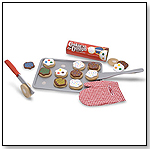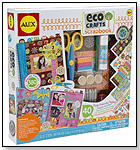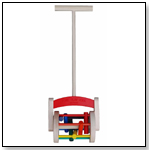|
|
How to Prove You're Really "Green" Full Transparency Will Set You Apart From Pretenders
“By specifying test methods used for specific materials and components of the toy or baby product and sharing this information on the package or company website, manufacturers will be properly educating the consumer and taking steps to protect themselves against possible legal action,” Susan Herbert, vice president of science strategy at TerraVeritas, a sustainability validation services company, advised TDmonthly Magazine. (See End Note: How to Back Up Your Eco-Claims) Making Green More Meaningful 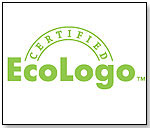 “Green awareness has grown throughout the toy industry due to many factors — product safety issues, wider realization of our precarious planet, and a broadening of principles to reflect daily practices,” toy expert Dr. Stevanne Auerbach (aka “Dr. Toy”) told TDmonthly. “Green awareness has grown throughout the toy industry due to many factors — product safety issues, wider realization of our precarious planet, and a broadening of principles to reflect daily practices,” toy expert Dr. Stevanne Auerbach (aka “Dr. Toy”) told TDmonthly.“Many toy companies are already making great strides, tracking materials used in their products, reducing waste and energy use in their manufacturing processes, and ensuring that their products are packaged in recycled materials,” added Catherine Wilt, director of policy at the University of Tennessee’s Center for Clean Products. However, as consumer awareness about health and the environment grows, so will the need for more specific information. Here are some strategies that may help you compete in the ever-greener toy industry: 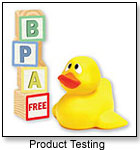 Go for Multi-Attributes. Retailers and manufacturers should avoid focusing on a single issue and instead include details about how their toys or baby products reduce multiple environmental impacts. A wooden toy can have its raw materials certified by a credible third-party such as the Forest Stewardship Council for sustainable forestry practices, while other impact areas such as packaging, chemicals used in processing, and greenhouse gases emitted during the manufacturing process should also be addressed. While single-environmental-attribute claims such as energy efficiency are a step in the right direction, multi-attribute claims take a broader look at the lifecycle of a product. Go for Multi-Attributes. Retailers and manufacturers should avoid focusing on a single issue and instead include details about how their toys or baby products reduce multiple environmental impacts. A wooden toy can have its raw materials certified by a credible third-party such as the Forest Stewardship Council for sustainable forestry practices, while other impact areas such as packaging, chemicals used in processing, and greenhouse gases emitted during the manufacturing process should also be addressed. While single-environmental-attribute claims such as energy efficiency are a step in the right direction, multi-attribute claims take a broader look at the lifecycle of a product. List Ingredients and Tests. “A key issue is that manufacturers are required to test for only a handful of chemicals in children’s products and are not required to list product constituents,” said Dr. Sally Edwards, director of the Sustainable Children’s Products Initiative at the Lowell Center for Sustainable Production, University of Massachusetts, Lowell.
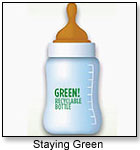 Focus Your Message. Dr. Edwards recommended that manufacturers and retailers develop relationships with their suppliers to ensure that they know the chemicals and materials used in making their products. Barbara Rainville, Maple Landmark Woodcraft’s marketing manager, told TDmonthly that her company’s Vermont-made wooden toys are tested for lead and phthalates. Interestingly, she pointed out that “lead-free” claims get better reception from consumers because the health implications are well understood, whereas they seem less receptive to claims around phthalates since this is a relatively new issue with conflicting science. Focus Your Message. Dr. Edwards recommended that manufacturers and retailers develop relationships with their suppliers to ensure that they know the chemicals and materials used in making their products. Barbara Rainville, Maple Landmark Woodcraft’s marketing manager, told TDmonthly that her company’s Vermont-made wooden toys are tested for lead and phthalates. Interestingly, she pointed out that “lead-free” claims get better reception from consumers because the health implications are well understood, whereas they seem less receptive to claims around phthalates since this is a relatively new issue with conflicting science. Get a Stamp of Approval. Finally, there is good news for North American manufacturers and retailers. EcoLogo, one of North America’s oldest and most respected multi-attribute environmental standards and certification marks, is in the process of developing criteria for the first comprehensive environmental toy standard for use in the U.S. and Canada. The standard is expected to be complete by the end of 2010. Visit www.ecologo.org to find out more about the upcoming standard. How to Back Up Your Eco-Claims Here’s how to gain retailer and consumer trust when using some of the most common green-related claims: Biodegradable: There are several definitions for biodegradability (e.g. “readily” or “inherent”) that each have separate test methods specified by credible guidelines from the Organization for Economic Co-Operation and Development (OECD: www.oecd.org), the American Society for Testing and Materials (ASTM: www.astm.org) and the International Standard Organization (ISO: www.iso.org), to name a few. Specific details about the “biodegradability” claim should be provided and a valid guideline should be referenced for the claim to be considered credible. Lead-free: The term “lead-free” became popular thanks in large part to toy recalls between 2006 and 2008 owing to high levels of lead found in children’s products. Support your claim of “lead-free” with information such as federally regulated test methods performed and the test results. Phthalate-free: This claim gained public attention when the plastic softening agent, which can lead to negative health effects as a result of hormone disruption, was found leaching from baby products like teething rings. Prominence of these issues in the media and with the public has greatly increased claims of “phthalate-free” on children’s products. Federally regulated test methods and the test results should be made publicly available at minimum on the company website. BPA-free: BPA (Bisphenol-A) is an estrogenic chemical used in making polycarbonate plastic drinking and baby bottles as well as many other products. While several U.S. states and the Canadian federal government have placed bans on BPA in plastic baby bottles, claiming that a product is “BPA-free” is insufficient without third-party certification or verification. The Environmental Protection Agency (EPA: www.epa.gov) announced in March that it is looking to add BPA to its list of chemicals of concern, which could mean regulation and required testing related to environmental effects. Eco-friendly: “Eco-friendly” implies that the product is good for the environment, but consumers need more information to determine whether the product has the green attributes of interest to them. Additional details to support this claim might include third-party certifications such as the Global Organic Textile Standard (GOTS: www.global-standard.org), which only certifies textile products that contain a minimum of 70 percent organic fibers and also covers environmentally and socially responsible manufacturing and labeling. Organic: Claims like “organic” found on cotton baby bibs and children’s stuffed toys should carry proof, such as a credible certification of a standard like USDA Organic (www.ams.usda.gov). Products labeled “organic” under the USDA standard must consist of at least 95 percent organically produced ingredients (excluding water and salt). Interestingly, this standard does not cover the processes by which it was made into cloth, nor the finished product. This means marketers will want to be specific about what exactly is certified.  Writer's Bio: Communications Consultant for TerraChoice, Kate Rusnak works with clients to help environmental leaders deliver the most impactful stories and messages about their greener products, services, and practices in an effort to help them grow market share and develop their sustainability positioning. To learn more about TerraChoice, visit www.terrachoice.com. Read more articles by this author Writer's Bio: Communications Consultant for TerraChoice, Kate Rusnak works with clients to help environmental leaders deliver the most impactful stories and messages about their greener products, services, and practices in an effort to help them grow market share and develop their sustainability positioning. To learn more about TerraChoice, visit www.terrachoice.com. Read more articles by this author |
| ||||||||||||||||||||||||||||||||||
Disclaimer Privacy Policy Career Opportunities
Use of this site constitutes acceptance of our Terms of Use.
© Copyright 2025 PlayZak®, a division of ToyDirectory.com®, Inc.

